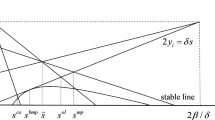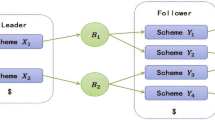Abstract
This paper considers a novel formulation of the multi-period network interdiction problem. In this model, delivery of the maximum flow as well as the act of interdiction happens over several periods, while the budget of resource for interdiction is limit. It is assumed that when an edge is interdicted in a period, the evader considers a rate of risk of detection at consequent periods. Application of the generalized Benders decomposition algorithm considers solving the resulting mixed-integer nonlinear programming problem. Computational experiences denote reasonable consistency with expectations.
Similar content being viewed by others
References
Department of Homeland Security (DHS). A roadmap for cybersecurity research. Department of Homeland Security (DHS), Technical Report, November, 2009
Allende, G.B., Still, G. Solving bilevel programs with the KKT-approach. Math. Program., Ser. A, 138: 309–332 (2013)
Chang, C.T. An efficient linearization approach for mixed-integer problems. European Journal of Operational Research, 123(3): 652–659 (2000)
Corely, H.W., Sha, D.Y. Most vital links and nodes in weighted network. Operations Research Letters, 1: 157–160 (1982)
Cormican, K.J., Morton, D.P., Wood, R.K. Stochastic network interdiction. Operations Research, 46: 184–197 (1998)
DeNegre, S. Interdiction and discrete bilevel linear programming. Doctoral disssertation, Lehigh University, 2011
Fulkerson, D.R., Harding, G.C. Maximizing the minimum source-sink path subject to budget constraint. Mathematical Programming, 13: 116–118 (1977)
Geoffrion, A.M. Generalized Benders decomposition. Journal of Optimization Theory and Applications, 10(4): 237–260 (1972)
Glover, F. Improved linear integer programming formulations of nonlinear integer problems. Management Science, 22(4): 455469 (1975)
Golden, B. A problem in network interdiction. Naval Research Logistics Quarterly, 25: 711–713 (1978)
Israeli, E., Wood, R.K. Shortest-path network interdiction. Networks, 40(2): 97–111 (2002)
Gm, H.Z., Floudas, A.C. Global optimization of mixed-integer bilevel programming problems. Computational Management Science, 2(3): 181–212 (2005)
Kettani, O. Oral, M. Equivalent formulations of nonlinear integer problems for efficient optimization. Management Science, 36(1): 115119 (1990)
Klaus, C. Network design for reliablity and resilience to attack. Doctoral disssertation, Naval Postgraduate School, 2014
Larsson, T., Yuan, D. An augmente lagrangean algorithm for large scale multicommodity routing. Computational Optimization and Applications, 27 (2): 187–215 (2004)
Malaviya, A., Rainwater, C., Sharkey, T. Multi-period network interdiction problems with applications to city-level drug enforcement. IIE Transactions, 44: 368–380 (2012)
McMasters, A.W., Mustin, T.M. Optimal interdiction of a supply network. Naval Research Logistics Quarterly, 17: 261–268 (1970)
Saharidis, G.K. Ierapetritou, M.G. Resolution method for mixed integer bi-level linear problems based on decomposition technique. J. Glob. Optim., 44: 20–51 (2008)
Stackelberg, H. The Theory of the Market Economy. William Hodge and Co., London, U.K., 1952
Sterbenz, J.P.G., Hutchison, D., Cetinkaya, E.K., Jabbar, A., Rohrer, J.P., Scholler, M., Smith, P. Resilience and survivability in communication networks: strategies, principles, and survey of disciplines. Computer Networks, 54(8): 12451265 (2010)
Wen, U. Yang, Y. Algorithms for solving the mixed integer two-level linear programming problem. Comput. Oper. Res., 17: 133–142 (1990)
Wollmer, R.D. Removing arcs from a network. Operations Research, 12: 934–940 (1964)
Wood, R.K. Deteministic network interdiction. Mathematical and Computer Modeling, 17: 1–18 (1993)
Woodruff, D.L. Network interdiction and stochastic integer programming. Kluwer Academic Publishers, 2003
Acknowledgements
The authors would like to thank Azarbaijan Shahid Madani University for supporting this paper.
Author information
Authors and Affiliations
Corresponding author
Additional information
Supported by Azarbaijan Shahid Madani University.
Rights and permissions
About this article
Cite this article
Soleimani-Alyar, M., Ghaffari-Hadigheh, A. Solving multi-period interdiction via generalized Bender’s decomposition. Acta Math. Appl. Sin. Engl. Ser. 33, 633–644 (2017). https://doi.org/10.1007/s10255-017-0687-9
Received:
Revised:
Published:
Issue Date:
DOI: https://doi.org/10.1007/s10255-017-0687-9
Keywords
- Bi-level programming
- network interdiction
- mixed-integer nonlinear programming
- generalized benders decomposition




